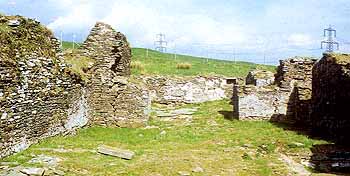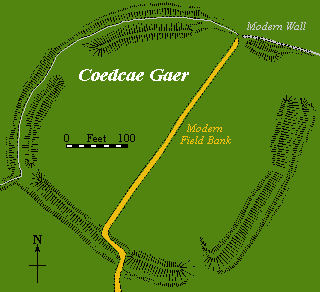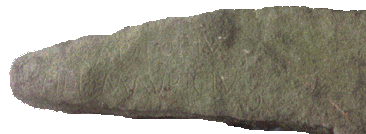
EBK Home
Kingdoms
Royalty
Saints
Pedigrees
Archaeology
King Arthur
Mail David
 MYNYDD-Y-
GAER
MYNYDD-Y-
GAERBurial Place of Uther, Arthur or Athrwys?
The Tradition: Medieval accounts of the Arthurian story, including Geoffrey of Monmouth's "History of the Kings of Britain," tell how Uther Pendragon was buried at or near a place called Caer Caradog (which Geoffrey mistakenly identifies as Sailsbury).
The Theory: Blackett & Wilson claim that one of the two figures who went to make up "King Arthur" is to be identified with King Athrwys of Gwent & Glywysing. Athrwys (or Arthwys) was an historical monarch who is usually believed to have lived in the mid-7th century, though Blackett & Wilson push him back in time to the traditional Arthurian period at the beginning of the 6th century. They interpret "Uther Pendragon" as a title used by both Athrwys and his father, King Meurig ap Tewdr. Following numerous clues, they claim to have traced King Athrwys' burial-place first to a secret cave and then to a re-interment in the ruined Church of St.Peter-super-Montem on Mynydd-y-Gaer in Mid Glamorgan. The fort of Coedcae Gaer on a spur projecting south-eastward from here, is marked on old maps as Caer Caradog. Barber & Pykitt follow Blackett & Wilson, but take the more obvious line of claiming this as the burial-place of Meurig ap Tewdr alias Uther Pendragon. Modern
Archaeology:
Blackett & Wilson's hypothesis hit the headlines in 1983, and
created much interest across the country. Unfortunately, this also brought
notoriety to some of the places that they revealed to have Arthurian
associations; and the secret burial cave subsequently suffered a
series of attacks by vandals. Concerned about the site that they believed
to contain Arthur's last resting-place, Blackett & Wilson undertook a
private excavation near the altar of St. Peter's Church. Here they
claim to have discovered a large sword-shaped memorial which reads, in
very faint 6th century style, "Rex Artorius fili Mauricius" (picture
below - text outlined). Beneath this was a grave which they hurriedly
sealed for future investigation.
Modern
Archaeology:
Blackett & Wilson's hypothesis hit the headlines in 1983, and
created much interest across the country. Unfortunately, this also brought
notoriety to some of the places that they revealed to have Arthurian
associations; and the secret burial cave subsequently suffered a
series of attacks by vandals. Concerned about the site that they believed
to contain Arthur's last resting-place, Blackett & Wilson undertook a
private excavation near the altar of St. Peter's Church. Here they
claim to have discovered a large sword-shaped memorial which reads, in
very faint 6th century style, "Rex Artorius fili Mauricius" (picture
below - text outlined). Beneath this was a grave which they hurriedly
sealed for future investigation.
Subsequent excavations undertaken in 1990 by Dr Eric Talbot of Glasgow University and a team of professional archaeologists, with the permission of the RCAHMW, have revealed that below the present church (of 13th century origin) lie the remains of at least two earlier building phases: A solid rectangular building covering an earlier "beehive" hermitage and rectangular paved (possibly) wooden erection. Significant finds included a small electrum cross bearing the inscription, "Pro Anima Artorius".
 Possible
Interpretations & Criticism:
Despite flying in the face of much accepted doctrine concerning a Real
King Arthur, many of Blackett & Wilson's arguments are extremely
compelling. Coedcae Gaer may be translated as Forest of Cai Fort
which might sound like further evidence for their identification of the
great High-King Arthur. However, whether one accepts this or not, the
question still remains, "Did they find the Grave of King Athrwys
of Gwent & Glywysing?" As the initial discovery of the
memorial stone at St.Peter's Church there had no official supervision,
this major find has thus come in for considerable criticism. It is true
that Early Medieval Latin is so corrupt that it is difficult to claim any
particular inscription to be incorrect, but still something like "Artorius
Rex filius Mauricii" would read much better, and surely the letters
are much too regular for a 6th century context. But then again,
the corroborative cross inscribed "For the Soul of Artorius"
recovered under better documented circumstances would indicate that the
site is indeed associated with a man named Arthur, and the King of Gwent
& Glywysing would seem the most likely candidate. The
"beehive" cell would certainly indicate St. Peter's to be the
site of a 5th or 6th century hermitage. The associated rectangular
building was probably of similar date, though Blackett & Wilson's
interpretation is a little more controversial.
Possible
Interpretations & Criticism:
Despite flying in the face of much accepted doctrine concerning a Real
King Arthur, many of Blackett & Wilson's arguments are extremely
compelling. Coedcae Gaer may be translated as Forest of Cai Fort
which might sound like further evidence for their identification of the
great High-King Arthur. However, whether one accepts this or not, the
question still remains, "Did they find the Grave of King Athrwys
of Gwent & Glywysing?" As the initial discovery of the
memorial stone at St.Peter's Church there had no official supervision,
this major find has thus come in for considerable criticism. It is true
that Early Medieval Latin is so corrupt that it is difficult to claim any
particular inscription to be incorrect, but still something like "Artorius
Rex filius Mauricii" would read much better, and surely the letters
are much too regular for a 6th century context. But then again,
the corroborative cross inscribed "For the Soul of Artorius"
recovered under better documented circumstances would indicate that the
site is indeed associated with a man named Arthur, and the King of Gwent
& Glywysing would seem the most likely candidate. The
"beehive" cell would certainly indicate St. Peter's to be the
site of a 5th or 6th century hermitage. The associated rectangular
building was probably of similar date, though Blackett & Wilson's
interpretation is a little more controversial.
